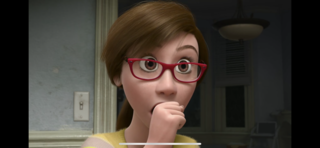
Anger
Disney Plus Dream Job: Inside Out
Viewing Inside Out through a psychiatrist's lens
Posted December 8, 2019
Introduction
Faculty, residents, and students at my university are participating in the Disney Plus Dream Job and watching 30 Disney films in 30 days. Welcome to our Day #11 blog post! Course directors successfully incorporated the 30 films (and shows) into our preexisting curriculum that teaches psychiatry to future physicians through film and other aspects of popular culture. Views Through the Psychiatrist’s Lens will publish daily blogs throughout the 30-day Disney Plus Dream Job. Our eleventh blog is on the 2015 film, Inside Out.
Synopsis
Inside Out is a 2015 computer-animated film produced by Pixar Animation Studios and released by Walt Disney Pictures. The film is set in the mind of a young girl named Riley. We are introduced to five personified emotions that struggle in their adjustment to their unfamiliar surroundings after moving into a new home.
At the time of this posting, the film holds a rating of 8.2 out of 10 on IMDb and a rating of 98% on Rotten Tomatoes.
How it relates to the field of psychiatry
Inside Out (2015) focuses on Riley’s adjustment to her new home upon moving from Minnesota to San Francisco. If one were to edit the film and delete the personified emotions, Riley’s behavior would grow concerning and become the focus of clinical attention. On her first day of school, Joy and Sadness are sucked out of Headquarters and sent to long-term memory (LTM) storage. While the film then follows the trials and tribulations of Joy and Sadness as they try to find their way back to Headquarters, it’s actually the three remaining emotions that push the narrative forward.
In the absence Joy and Sadness, Anger, Fear, and Disgust are left in control. These persisting “emotions” result in clinically significant distress and interpersonal impairment as evidenced by Riley isolating herself from her parents, friends, and hobbies. Taken together, an Adjustment Disorder with mixed disturbance of emotions and conduct would be an appropriate provisional diagnosis.
At this point, the clinician would investigate whether Riley’s symptoms are better accounted for by the direct physiological effects of a substance of another medical condition. As for the latter, evaluation can proceed in two steps. Our initial step is to observe whether there is discrete evidence in the film that Riley demonstrates signs indicative of an underlying medical condition. In the absence of such information, our second step would be to consider a medical condition nonetheless given identified risk factors (e.g. age).
Since Riley is 11 years old, it is unlikely that she would have a medical illness that would explain her anger, fear, and disgust in the absence of any physical signs.
Riley’s age, however, does not preclude the role of a substance as central to the pathophysiology of her mixed emotions. This formulation would be further strengthened by supportive evidence of drug use in the film. The only intoxication syndrome that would account for all three of Riley’s symptoms - anger, fear (anxiety), and disgust (apathy) – is stimulant intoxication.

Here, we’ll take some creative liberty and interpret Riley’s mother’s cough (Figure 1) as evidence that dextromethorphan hydrobromide (DXM) is in the house.
DXM is the most popular cough suppressant (antitussive) medication in the US. A megadose of DXM is defined as 5-10 times the dose recommended for antitussive effect (1). At doses <600 mg, DXM is a serotonin and norepinephrine reuptake blocker leading to enhanced emotional response and sensitivity.
There are two additional scenes in the film that appear to corroborate the idea that Riley’s emotions may be the product of DXM abuse. First, the co-occurring use of alcohol would explain her personality islands falling into the “Memory Dump” where her core experiences are forgotten. The drug combination of DXM and alcohol (or soda) is commonly called ‘blue-purple drank’ which seems to be illustrated in the film (Figure 2).

Second, at doses >600 mg, the primary mechanism of action of DXM is blockade of excitatory N-methyl-D-aspartate (NMDA) receptors (2), a mechanism of action similar to phencyclidine (PCP) (3) and ketamine (4). Users often report a deep meditative state where they can create universes in their minds by just thinking of them (sound familiar?!).
DXM is a potential drug of abuse that at high doses can have dissociative properties similar to PCP, ketamine, and Salvia divinorum. At lower doses, DXM has a stimulant-like effect that may be sought by individuals to self-medicate an Adjustment Disorder such as moving into a new home.
References
Schwartz, R. H. (2005). Adolescent Abuse of Dextromethorphan. Clinical Pediatrics, 44(7), 565–568.
Church J (1990) Dextromethorphan, dysphoria and NMDA receptors. Neuromodulatory effects of dextromethorphan: role of NMDA receptors in responses. Trends Pharmacol Sci 11:146–147.
Morris BJ, Cochran SM, Pratt JA (2005) PCP: from pharmacology to modelling schizophrenia. Curr Opin Pharmacol 5:101–106.
Sinner B, Graf BM (2008) Ketamine. Handb Exp Pharmacol 182:313–333.



